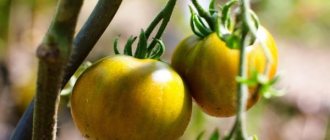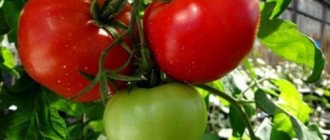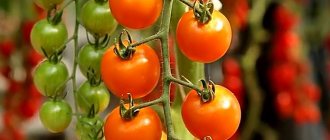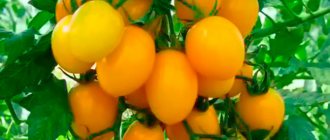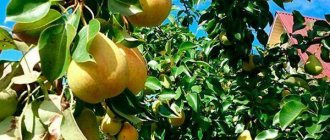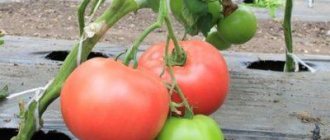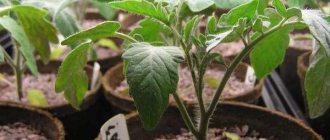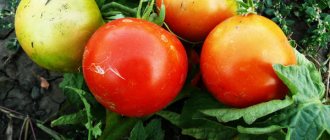The Dietary Healthy tomato is a valuable contribution to the health of every gardener. Healthy tomatoes contain a full range of vitamins and minerals, carotenoids, and lycopenes.
| Height | Landing location | Ripening time | Fruit color | Fruit size | Origin | Fruit shape |
| Medium height | Greenhouse, Open ground | Mid-early | Orange | Large | Variety | Flat-round |
Agricultural technology of tomato Dietary big guy
Determinate tomatoes are grown by seedlings, in May or early June (it all depends on the conditions of the region) by planting the plants in a greenhouse, on ridges. By following simple agricultural techniques, you can get up to 5 kg of fruit from each plant of this tomato variety.
Growing seedlings
The age of tomatoes when planted in a permanent place is approximately 55-60 days. Therefore, when calculating sowing juice, it is necessary to take into account:
- approximate date of transplanting tomatoes into the ground or under cover;
- climatic conditions of the area;
- weather in a particular season;
- days required for tomatoes to sprout.
The approximate time for sowing seeds is mid-March. Seeds must be prepared for sowing: disinfected with potassium permanganate, hardened, soaked in a growth stimulator.
Prepare nutritious soil for tomatoes and containers in which they will be grown in advance.
ON A NOTE! First, tomatoes can be sown in common containers or boxes, and then picked into separate cups.
When germinating seeds, the temperature is kept at +25ºC...+27ºC, but as soon as the first shoots appear, the boxes are exposed to light and the temperature is reduced. For about 5-6 days, the seedlings are kept at a temperature of +18ºC...+20ºC, and then raised again to +23ºC...+25ºC.
Water the seedlings moderately, avoiding excess moisture in the soil. When the tomatoes have 2-3 true leaves, they need to be picked.
Subsequent care before planting includes watering, fertilizing (complex formulations can be used), and ventilation of the room.
About 10 days before transplanting, tomatoes need to be accustomed to new conditions. Hardening is carried out gradually, taking the seedlings out onto the veranda or balcony, first for 15-20 minutes, then leaving them there for several hours.
It is also recommended to leave the tomatoes in the greenhouse overnight about two days before planting. This will allow the seedlings to adapt faster and then grow.
Tomato care: features
When grown in a greenhouse, and Dietary Healthy is recommended to be cultivated in protected soil, it is important to observe the temperature regime and humidity level.
The temperature in the greenhouse during the day should be approximately +20ºC...+25ºC, at night +18ºC. Changes below +13ºC and above +32ºC are dangerous. If the temperature is too high, the properties of the pollen in tomatoes deteriorate, it becomes sterile and there will be no ovaries.
IMPORTANT! A necessary technique is to ventilate the greenhouse with tomatoes. On hot summer days, the greenhouse does not need to be closed at night.
There should be no trees or buildings around the greenhouse where tomatoes grow. In poor lighting conditions, crop yields are noticeably reduced. You should also wipe the windows in the greenhouse from time to time to allow sunlight to penetrate freely.
How to water a tomato
Immediately after planting the Healthy seedlings in the greenhouse, you should wait about a week and not water the plants. Then watering is carried out regularly, about twice a week.
Increase the number and volume of watering during budding and flowering of tomatoes, then reduce it during fruiting. In a greenhouse, tomatoes are watered at the roots, or into grooves or holes, without getting on the leaves or flowers of the plants. It is advisable to ventilate immediately after watering to reduce the humidity inside the greenhouse. Water is only warm and settled. A mistake many novice gardeners make is watering tomatoes with unsettled and, moreover, cold water. This can cause plant rot and various diseases. The optimal water temperature should be +20ºC.
Fertilizer application
Tomatoes begin to be fed 18-20 days after planting, alternating organic matter and mineral fertilizers. For the first feeding, you can use diluted mullein (1:10), poultry droppings (1:15).
After two weeks, the next feeding is carried out, introducing phosphorus and potassium fertilizers into the “menu” of tomatoes. You can use green infusions (on nettle, other weeds) or infusions on ash. The Dietary Big Man reacts well to foliar feeding, for which you can use boric acid, iodine, yeast or ready-made commercial compounds.
Forming tomatoes
Tomato Dietary healthy needs the formation of a bush, this allows you to increase productivity. Usually it is grown in one or two stems, keeping only one stepson under the first cluster.
All other stepsons are removed, and it is advisable to carry out this procedure twice a week.
Around mid-August, pinch the top of the tomato, remove all the flower clusters formed at that time, as well as the smallest fruits. This allows all set fruits to form normally and have time to ripen.
You also need to remove the lower leaves of tomatoes, but this must be done very carefully and gradually. By the time the first cluster bears fruit, all the lower leaves on the stem of the bush should be removed.
ON A NOTE! It is best to remove shoots and leaves from bushes in the morning. You cannot remove more than three leaves at a time, otherwise it will stress the plant.
The leaves are removed horizontally, but the skin on the plant stem must not be damaged. If you do pruning in the morning, the wounds will heal within a day, and infection will not get into them.
Another very important technique when growing Diet Healthy: thinning the flower clusters. 3-4 fruits are left in them, which makes it possible to obtain tomatoes weighing from 350 to 450 grams. If you leave all the fruits in the cluster, they will grow to an average of 150 grams.
Characteristics of the fruit
The Healthy tomato has a round, regular shape and a smooth surface. The tomato skin is quite dense, which ensures the safety of the fruit during transportation. Ripe vegetables take on a matte orange hue. The description of the fruit characterizes the average weight of one tomato ranging from 300 to 500 grams. Reviews from gardeners indicate that the weight and size of tomatoes is directly affected by agricultural cultivation techniques and the degree of control of the ovaries.
Compliance with the basic rules of agricultural technology allows you to harvest up to 5 kg of vegetables from one plant bush.
A distinctive feature of the variety is the fleshiness, juiciness and aroma of the fruit. Due to this feature, the variety is excellent for preparing light vegetable salads and preparing tomato juices. Tomatoes can give first and second courses a unique rich taste when used as recipe ingredients.
A unique property of tomatoes of this variety is considered to be a low content of acids, which are contraindicated for diseases of the gastrointestinal tract. Thanks to this feature, tomatoes can be eaten by almost everyone. Contraindication for use is not even childhood. At the same time, the composition of vegetables is rich in keratin, which, when it enters the human body, improves the functioning of all organs. It was the unique composition of the fruits of the variety that led to the appearance of an unusual variety - Dietary Healthy.
See also
Description of the tomato variety Gigant Novikova, reviews and yieldRead
Rules for growing the variety
Tomatoes of the Dietary Healthy variety are grown by seedlings at the very end of spring or beginning of summer. Plants are planted in a greenhouse or in beds. Tomatoes are planted in a permanent place when they are already about 2 months old. Seeds are sown around mid-March or a little later, focusing on the climate in the region.
Seedlings need moderate watering, since excess moisture in the soil is prohibited. Picking is carried out at the moment when the tomatoes have 2-3 leaves. Then care includes watering, fertilizing, airing the premises, and gradually acclimating to the new temperature regime.
- It is desirable that the temperature be +20-25 degrees, at night - +18 degrees. Temperature fluctuations are dangerous.
- In situations where tomatoes are grown in greenhouses, ventilation is required. On hot days the greenhouse is left open.
- Sunlight is essential for a good harvest.
- Seedlings are watered only after they are more than a week old. Then watering is carried out twice a week. However, tomatoes are watered more often and more during budding and flowering, and less when fruiting. It is advisable to water the plants with extreme caution to protect the leaves from unwanted moisture. For the procedure, use only water at room temperature, which it is advisable to pre-settle.
- Approximately 3 weeks after transplanting tomatoes, fertilizers begin to be applied. To do this, alternate organic and mineral compositions. Often, this approach and regular fertilization contribute to the successful and proper development of the Dietary Healthy tomato variety. It should be noted that Dietary Husky responds very well to foliar application of fertilizers that require boric acid, iodine or yeast.
- Forming a tomato bush is necessary to obtain the desired harvest. To do this, you need to grow a tomato with 1-2 stems. Any measures to form bushes are carried out with special care.
- Prevention of diseases and parasites is required, because Dietary Healthy turns out to be a vulnerable variety. The most important thing is to use green manure and observe sowing rotation. Additionally, preventive measures are carried out using chemical or natural agents to successfully combat various risks to tomatoes.
- Proper care of tomatoes of the Dietary Healthy variety guarantees continued receipt of a high-quality harvest.
Prevention from diseases
The most reliable protection against tomato diseases will be compliance with all rules for caring for the crop. And to do this, it is necessary to observe crop rotation, carry out mandatory disinfection of the greenhouse, and practice sowing in the shelter of green manure. Not every gardener has the opportunity to change the place where tomatoes are planted; they are usually grown every year in the same greenhouse.
This means that it is necessary to disinfect the shelter, remove the top layer of soil, and sow green manure in the fall, which enriches the soil and disinfects it.
When growing tomatoes, do not forget about treating plants against diseases:
- spraying with compositions containing the Barrier preparation, ash infusion, infusion with garlic;
- processing tomatoes with Bordeaux mixture.
If traces of late blight are noticeable, you can spray with Oxyx.
Advantages and disadvantages that gardeners note in reviews
Large fruit size is not the only advantage of the Cyrano tomato:
- Easy cultivation. The bushes are developing rapidly.
- High keeping quality. It is possible to store both ripe and still green tomatoes. The latter are placed in boxes or on window sills.
- The thick skin allows tomatoes to be transported over long distances. Tomatoes do not wrinkle and retain their impeccable presentation.
- The crop has genetic resistance to most common diseases (including tomato mosaic, root-knot nematodes and fusarium. Cladosporiosis and verticillium wilt are extremely rare).
The hybrid also has disadvantages:
- It is necessary to regularly prun the bushes.
- The plant is demanding on soil maintenance, especially during the filling period.
- The pulp is sugary and juicy. The collection can be divided into 2 stages, because The first batch of tomatoes is ready in just a month. The fruits store well; in a cool place they can last until autumn. Sirano tomatoes make delicious salads, you can prepare lecho (Nadezhda, Rostov region)
- The tomato is one of the brightest in the garden. The fruits are even, of the same shape and size, and look elegant. The care is standard, but you need to add fertilizing, this affects the quality of the tomatoes (Nikolai, Altai Territory).
